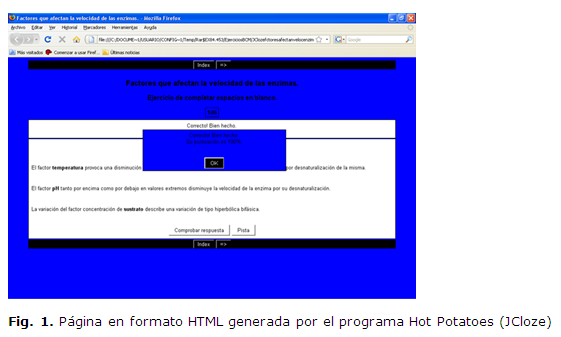Elaboration of Interactive Self-Evaluation Exercises with the Software HotPotatoes for the Subjects Human Morphology and Physiology I and II
Keywords:
Teaching, Medical education.Abstract
A set of one-hundred exercises was elaborated using the software Hot Potatoes aiming at contributing with the teaching-learning process of the eukaryote cell’s morphology and physiology, in order to facilitate interactive teaching. Different kinds of exercises were generated: fill-in the blanks, crosswords, matching, true or false, multiple-choice, and ordering of phrases and sentences. The main advantaged offered by the software Hot Potatoes are: automatic correction of the answers (at the end of each exercise, the student obtains a percentage qualification derived from both the number of correct and incorrect answers, and also based on he number of attempt to give each correct answer), and secondly, the availability for the professor to enter information regarding why an answer ins correct or is not (back-feeding). The exercises elaborated were incorporated to the lessons created for each topic, so that each student could make an evaluation on how much he/she had learned at the end of his/her independent review or session. Now there is no way to organize the teaching process (workshop lesson) among the lectures and seminars in which student could consolidate and systematize the received contents, so that the exercises may contribute to achieve the skills in each topic.Downloads
References
1. Hernández-Zárate SI, Medina-Bojórquez A, López-Tello Santillán AL, Alcalá-Pérez D. Epidemiología del cáncer de piel en pacientes de la Clínica de Dermatooncología del Centro Dermatológico Dr. Ladislao de la Pascua. Estudio retrospectivo de los últimos ocho años. Dermatol Rev Mex 2012[citado 2014 Feb 01]; 56(1): 30-37. Disponible en: http://www.medigraphic.com/pdfs/derrevmex/rmd-2012/rmd121e.pdf
2. Mora Ochoa M, Olivares Savigñon AR, González Gross TM, Castro Mela I. El sol: ¿enemigo de nuestra piel? MEDISAN [revista en la Internet]. 2010 Ago [citado 2014 Feb 01]; 14(6): Disponible en: http://scielo.sld.cu/scielo.php?script=sci_arttextpid=S1029-30192010000600014lng=es
3. Cuba. Infomed. Especialidades. Dermatología. Día del lunar en Cuba. La Habana: MINSAP; 2014. Disponible en: http://www.sld.cu/sitios/dermatologia/verpost.php?pagina=1&blog=http://articulos.sld.cu/dermatologia/&post_id=1248&c=
151&tipo=2&idblog=116&p=1&n=dca [citado 2014 Feb 01 ].
4. Sordo Carlos, Gutiérrez César. Cáncer de piel y radiación solar: experiencia peruana en la prevención y detección temprana del cáncer de piel y melanoma. Rev Peru Med Exp Salud Pública [serial on the Internet]. 2013 Mar [cited 2014 Feb 02]; 30(1): 113-117. Available from: http://www.scielosp.org/scielo.php?script=sci_arttextpid=S1726-46342013000100021lng=esnrm=isotlng=es
5. Dan Zheng DA, Giljohann DL, Chen MD. Massich XW, Chad AM.Topical delivery of siRNA-based spherical nucleic acid nanoparticle conjugates for gene regulation. PNAS[ìntenet]. 2012[citado 2014 jul 12]; 109(30): 11975-980. Available from: http://www.pnas.org/content/109/30/11975.full.pdf+html
6. Cuba. Infomed. Servicio de noticia en salud Al Día. Descubren posible tratamiento sobre el cáncer de piel. La Habana: MINSAP; enero 21, 2011. Disponible en: http://boletinaldia.sld.cu/aldia/2011/01/21/descubren-posible-tratamiento-contra-el-cancer-de-piel/ [citado 2014 jul 12]
7. Fengju Song, Abrar A. Qureshi, Jiali Han. Increased Caffeine Intake Is Associated with Reduced Risk of Basal Cell Carcinoma of the Skin. Cancer Res[internet]. julio 1/2012[citado 2014 jul 12]; 72: 3282-3289. . Disponible en: http://cancerres.aacrjournals.org/content/72/13/3282.full
8. Schwartzentruber DJ, Lawson DH, Richards JM, et al. gp100 Peptide Vaccine and Interleukin-2 in Patients with Advanced Melanoma. N Engl J Med; junio 2/2011[citado 2014 jul 13]; 364(22): 2119-2127. Disponible en: http://www.intramed.net/contenidover.asp?contenidoID=71281

Published
How to Cite
Issue
Section
License
Authors who have publications with this journal agree to the following terms: Authors will retain their copyrights and grant the journal the right of first publication of their work, which will be publication of their work, which will be simultaneously subject to the Creative Commons Attribution License (CC-BY-NC 4.0) that allows third parties to share the work as long as its author and first publication in this journal are indicated.
Authors may adopt other non-exclusive license agreements for distribution of the published version of the work (e.g.: deposit it in an institutional telematic archive or publish it in a volume). Likewise, and according to the recommendations of the Medical Sciences Editorial (ECIMED), authors must declare in each article their contribution according to the CRediT taxonomy (contributor roles). This taxonomy includes 14 roles, which can be used to represent the tasks typically performed by contributors in scientific academic production. It should be consulted in monograph) whenever initial publication in this journal is indicated. Authors are allowed and encouraged to disseminate their work through the Internet (e.g., in institutional telematic archives or on their web page) before and during the submission process, which may produce interesting exchanges and increase citations of the published work. (See The effect of open access). https://casrai.org/credit/


